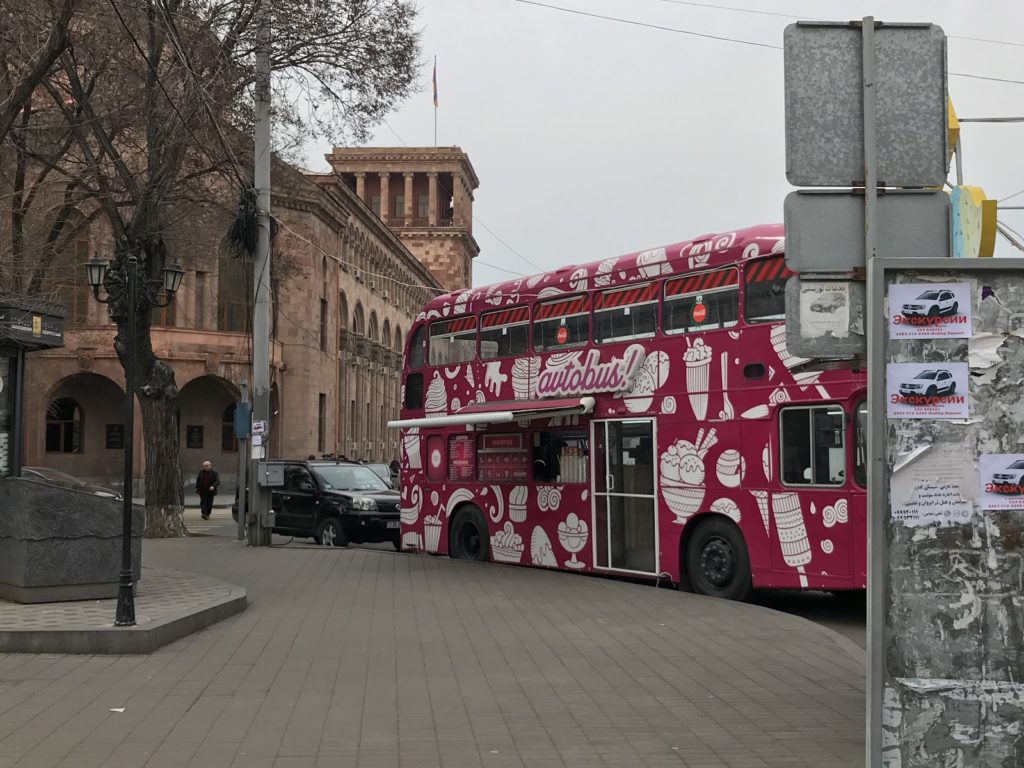
YEREVAN—Vintage Soviet-era buses and trucks have reappeared in force along the streets of the Armenian capital, creatively rebuilt and painted in bright colors. These old workhorses of the Soviet economy have been reborn as food trucks.
Yerevantsis [natives of the city] may find this new trend interesting, but they are not uninitiated to the concept. Traditionally, fast-food, coffee, ice-cream and even clothing from tiny stalls have always been available for purchase on-the-go, tucked on the sidewalks in small, typically sedentary vending areas known as ‘boutka,’ the Russian-language corruption of the French word ’boutique.’ Many of these were of dubious legality and construction. Despite universal agreement that the boutkas were an eyesore for the city, they remained popular with locals due to their convenience and affordability.
As the city’s beautification projects took off in earnest, many of these stalls would be dismantled. This act triggered the start of the food truck craze. Some among the more enterprising denizens attached small espresso machines to their bicycles and parked in front of large office buildings or university campuses.
Tourists walking around Republic Square could purchase a cappuccino from the back of a delivery van for half of what they could pay at the café in the lobby of the Marriott. Within a year, food trucks would become widespread across downtown Yerevan. At present, there are an estimated 60 food trucks operating across the city with many of the menus dominated by Western fast-food staples, but mobile shawarma stands can be discerned as well. No word yet on traditional Armenian meals.
Though food trucks have been a staple around construction sites or county fairs across North America, these four-wheeled cantinas are enjoying a revival and proliferation across the globe. Food-conscious millennial consumers have helped fuel this trend with their desire to try different cuisines at affordable prices.
For many mobile-food entrepreneurs, the food truck presents a proven, straightforward business model. The overhead costs are much lower than traditional restaurants. There are fewer employees to manage, and there are no long-term leases to negotiate. Most need a truck (or wagon) fitted with a kitchenette, one person to take orders and another to prep.
The continued effects of the Great Recession, which reached Armenia in 2009, have also pushed accomplished chefs into cheaper-to-operate food trucks. The result has been their rapid transformation from roach-coaches into gourmet food houses.
Though specialty coffee drinks and ice-cream remain staples of the food-truck menu, increasingly specialized lunch wagons offer enough exotic menu items to satisfy even the most fastidious of foodies, who keep track of where their next food truck meal is coming from via social media.
The presence of so many food trucks gives Yerevan a sort of “Portland of the Caucasus” vibe. Yerevantsis don’t seem to mind, judging by the long lines forming around lunch time.
The municipality, on the other hand, seems to have been taken by surprise. The city currently has no bylaws on the books to regulate the food-trucks. Most of them do not undergo health and safety inspections, don’t pay an operating fee, and do not file any tax paperwork. These businesses are unlikely to have commercial liability insurance either.

For many of them, operating in a legal grey-zone comes with its own set of complications. Parking is a significant issue. These long trucks or trailers often take up two or more spots. Many food-truck drivers report routine harassment from angry store-owners, while others compete with aggressive taxi drivers for the limited parking spaces in downtown Yerevan.
One food-truck operator, Alex Azizian, a repat from California shared stories of turf-wars with other food-trucks over parking locations. He recalls receiving threats from other food-truck owners over his mobile bubble-tea stand “competing with their business.”
Many park illegally on important thoroughfares, contributing to the city’s already bitter traffic problem. Some even tap into the electricity grid to power their stands. It’s unclear if this behavior is ignored or tolerated by the municipality.
With food trucks becoming increasingly visible in major cities, municipal governments have been moving quickly to regulate them. In most cases, they issue business permits to canteens which have passed health and safety, hygiene and vehicular inspections. Zoning and parking restrictions also apply.
A spokeswoman from City Hall informed the Armenian Weekly that they are aware of the problem. A motion is currently going through parliament which would empower the municipality to write bylaws governing food trucks. For policymakers, however, regulation may not be enough. New bylaws would need to be enforced.
To those considering an entry into the food-truck business, Azizian offers a word of caution. “In the future when there are regulations and locals [that] become more accepting, it will be possible. You will be in a saturated market and maybe still have angry people approach you. But if you’re not ready to fight every day, don’t do it!”


As a native Portlander, I like the sound of this. I wonder if Yerevan’ll have its own Voodoo Doughnut.
My mom said that whoever opens a good Mexican restaurant in Poland is gonna make a fortune. Probably the same for Armenia. I’d probably be inclined to open a soul food restaurant (cornbread, greens, etc) and decorate it with photos of Robert Johnson, I Dream of Jeannie, and the like.